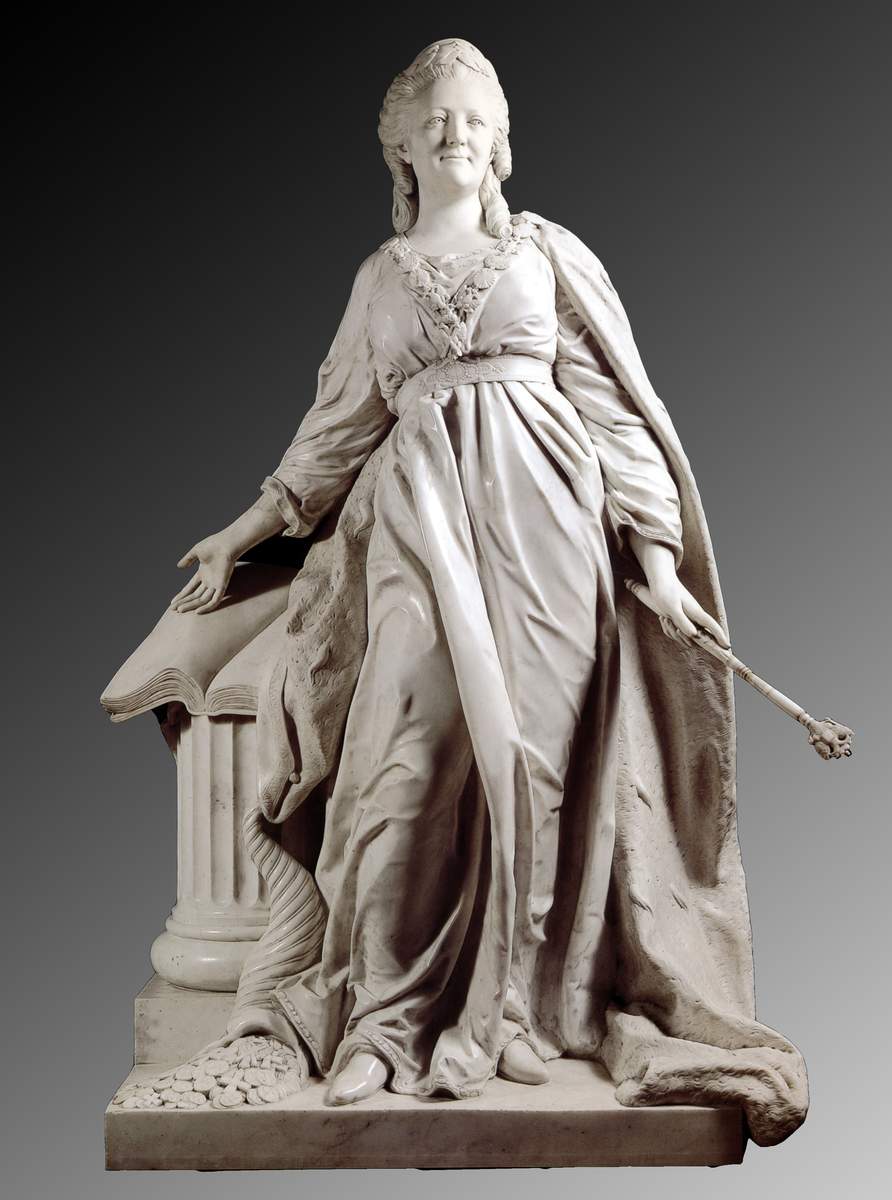


Статуя представляет собой аллегорический парадный портрет императрицы Екатерины II. В творчестве Ф. И. Шубина ее образ занимает значительное место. Статуя "Екатерина II — законодательница" создавалась для праздника, устроенного Г. А. Потемкиным в честь императрицы в Таврическом дворце. Для фигуры была сооружена специальная ротонда в Зимнем саду. Беломраморная статуя возвышалась на порфировом пьедестале, утопая в зелени, поблескивая в мерцании свечей. В облике императрицы, изображенной в диадеме с лавровым венком на голове, орденской цепью на груди, царским скипетром, торжественная парадность сочетается с индивидуальными чертами конкретной личности. Свободный хитон и горностаевая мантия не скрывают пропорций фигуры стареющей женщины. В трактовке парадного облика императрицы Шубин остался верен своему кредо — реалистической трактовке образа. За эту работу в 1794 году скульптор был удостоен звания профессора.
София Августа Фредерика Ангальт-Цербстская, немецкая принцесса (1729–1796), великая княгиня Екатерина Алексеевна, с 1762 — российская императрица Екатерина II.
Скульптор. Выдающийся скульптор русского классицизма, работал в жанре портрета. Родился в Архангельской губернии, в семье поморского резчика по кости. С помощью М. В. Ломоносова поступил в Академию художеств (ИАХ), где учился у Н. Ф. Жиле (1761 – 1766). С 1767 учился в Париже у Ж. Б. Пигалля, с 1770 – в Риме у Дж. Ноллекенса. За свое мастерство пользовался благоволением императрицы Екатерины II. Произведения Шубина: статуи, портретные бюсты, рельефы характерны пластическим чувством, «живой теплотой» мрамора. Его неповторимый стиль – сочетание психологизма, живописности и классицистической идеализации. В его портретах запечатлен весь высший свет Петербурга екатерининской эпохи.

This sculpture is an allegoric and an official portrait of Empress Catherine the Great. This sculpture of the Empress has an important place in Shubin’s work. This statue “Catherine the Legislatress” was created for a celebration organised by Grigory Potemkin in honour of the Empress at the Tauride Palace. A special rotunda was built in the Winter Garden for this statue. The white marble statue stands on a porphyry pedestal and is surrounded by greenery and gleamed by flickering candles. The appearance of the Empress, depicted wearing a tiara of laurel on her head, a chain on her chest and the Royal sceptre, is a combination of a ceremonial portrait and her individual features. The loose tunic and an ermine mantle does not conceal the proportions of the figure of the ageing woman. Shubin remained faithful to his realistic interpretation when he painted the ceremonial appearance of the Empress. For this work the sculptor was awarded the title of Professor in 1794.
Empress Catherine II (the Great; 1729–1796), née Sophie Friederike Auguste von Anhalt-Zerbst-Dornburg, was born in the Prussian city of Stettin. In 1744, she arrived in Russia as the bride of Grand Duke Peter Feodorovich, the future Emperor Peter III. That same year, she converted to Russian Orthodoxy and took the name Catherine Alexeyevna. She married Peter Feodorovich in August 1745. In 1754 she gave birth to an heir, the future Emperor Paul I. The relationship with her husband did not work out, and he planned to have her sent to a convent. In the summer of 1762 she led a conspiracy of Peter’s guards and overthrew him, becoming Empress. In the first years of her reign she adhered to a policy of “enlightened absolutism”, but after the peasant rebellion led by Emelyan Pugachev (1773–1775) and the French Revolution (1789), she was forced to toughen her regime. She led victorious campaigns against Turkey (1768–1774; 1787–1792) and Sweden (1788–1790). During her reign, the Crimea (1783), the Northern Baltic Sea, the Baltic states, the eastern part of Poland, and the Aleutian Islands became part of Russia. Russian settlements were established in Alaska, and Eastern Georgia was taken under the protection of Russia. Russia’s prestige in Europe increased greatly.
Leading Russian Neoclassical sculptor, portraitist. Son of a tusk carver in Archangel Province. Studied under Nicolas-Francois Gillet at the Imperial Academy of Arts through the intercession of Mikhail Lomonosov (1761-66), under Jean-Baptiste Pigalle in Paris (from 1767) and under Joseph Nollekens in Rome (from 1770). Combination of psychology and Neoclassical idealisation was highly rated by Catherine the Great. Portrayed many leading Russian statesmen.



